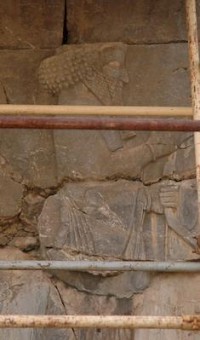Persepolis, Unfinished Tomb
Q71990867Persepolis (Old Persian Pârsa, modern Takht-e Jamshid): Greek name of one of the capitals of the ancient Achaemenid Empire, founded by king Darius the Great (r.522-486 BCE). There were several satellite sites, Naqš-e Rustam and Takht-e Rustam.
Unfinished Tomb

The relief of the "Unfinished tomb" at Persepolis was meant to be identical to all other Achaemenid royal tombs (like those at Naqš-e Rustam and the Tomb of Artaxerxes II Mnemon and the Tomb of Artaxerxes III Ochus in Persepolis), but was never completed.
When we visited the site (in 2005), we found this unfinished monument in scaffolds, as if people had decided to finally finish the tomb. This enabled us to make a close-up of the relief of the king. During a second visit (mid-2010), we found it still in scaffolds, as if not only the tomb, but also the restoration has been abandoned.
It is not known who was meant to be buried here, although it is of course tempting to think of Artaxerxes IV Arses (r.338-336) or Darius III Codomannus (r.336-330). Both projects might indeed have remained unfinished because of Alexander the Great's invasion of Iran and the subsequent unrest. However, the tomb is much lower than the two other funeral monuments in Persepolis, and the rock has strange layers that appear to be difficult to work upon. It is perhaps more likely that the tomb was left unfinished because the rock was not suited.